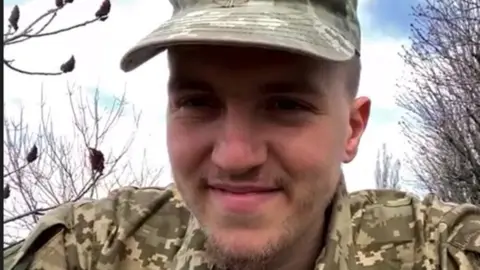Ukraine's battle for control of its skies
 BBC
BBCMuch of the focus of the war in Ukraine has so far been about the battle on the ground - but the fight to dominate the skies is just as important. The BBC has been given an exclusive interview with a Ukrainian air defence officer about the battle for control of Ukraine's skies.
Captain Vasyl Kravchuk has a surprisingly ready smile for a man who has endured 50 days of war. We spoke to him via video link from his base at an undisclosed location.
He knows the coming weeks will offer no respite. Russia may have received a bloody nose in its aborted attempts to take Kyiv, but with the Eastern region of the Donbas now firmly in Moscow's sights, the men and women of Dnipro's Anti-Aircraft Missile Brigade will continue to play a key role in the next phase of the war.
Defending Ukraine's skies from Russian attacks is already proving a challenge. As another Ukrainian air defence officer told the BBC, it is like trying to use a giant fly swatter which had large holes in it.
"We can't cover the whole airspace," Capt Kravchuk says simply.
The fact he is even sitting here speaking to us is somewhat remarkable - especially given the fact that "many air defence facilities were destroyed fully or partially" in the first days of the war.
It's a rare public admission by Ukrainian forces that they suffered significant losses in the early stages of the war.
But despite these losses, the air defences which survived have still been used to good effect.
Oryx, which has been tracking military losses during the war using visual confirmation, says that Ukraine has destroyed, damaged or captured at least 82 Russian aircraft, including jets, helicopters and drones.
Ukraine's equivalent aircraft losses stands at 33.
Indeed, their successes have confounded military experts, who predicted that Russia would quickly achieve air superiority over Ukraine.
Russia already had a significant advantage in the air, deploying more than three times as many combat aircraft as Ukraine. The US Pentagon says that Russian aircraft have been flying around 250 military missions and carrying out some 30 air strikes every day. Western officials still say that Russia is struggling to gain air superiority.
But in contrast, Ukraine's aging fleet of mostly MiG-29 fighter jets have been struggling to compete, managing at best around 10 military missions a day.
Ukraine knows that Russia has the upper hand in the air. That's why its repeatedly called on Western nations to close its skies.
But Russia's anticipated offensive in the Donbas presents a new, more difficult challenge.
Justin Bronk, senior research fellow for airpower at the Royal United Services Institute, says Russia is likely to have greater freedom of access in the airspace over the eastern region than the rest of the country due to its proximity to Russian controlled airspace.
In order to win the fight here, Ukraine requires a mix of long, medium and short range weapons to provide what's known as a "layered defence".
The West has been providing a significant number of shorter-range surface-to-air missiles. The US alone has already sent 2,000 Stingers. The UK has provided an unspecified number of Starstreak high velocity missiles too.
But while Capt Kravchuk says his country is grateful for those shoulder launched weapons, known as Manpads, he says they're only effective on the frontline.
This is because Manpads - man-portable air defence systems - are most effective against low flying aircraft. Russia is mostly using long range cruise missiles and high-altitude bombing.
Capt Kravchuk told the BBC: "We now lack medium and long range air defence systems... we do not have enough."
A renewed Russian offensive in the Donbas will put another serious strain on Ukraine's limited air defence.

While the focus of the war has turned to Eastern Ukraine, the rest of the country still needs protection. On the ground, we've seen evidence that Ukraine has been sending additional air defence systems to the east in recent days. But it can't afford to redeploy all its air defence systems to the Donbas region.
"We cannot leave half of Ukraine completely without protection," Capt Kravchuck says.
Ukraine is having to use its air defences not just to target Russian aircraft, but also Russian cruise and ballistic missiles. They are having some success, but they can't destroy everything.
Capt Kravchuk estimates that his unit is shooting down between 50-70% of Russia's longer-range missiles. As an example, he says when Russia fired six missiles around Dnipro recently they managed to stop four.
That still suggests a significant number are getting through. The Pentagon says that Russia has launched 1,550 missiles since the war began.
Russia says it's also been using hypersonic missiles. There isn't much Ukraine's air defences can do against those as they travel at five times the speed of sound.
But the harsh fact is that, without more significant support, Ukraine will find it increasingly hard to defend itself from Russian air and missile strikes the longer this war goes on.
A senior western intelligence official told the BBC that long and mid-range air defences were top of the list of Ukraine's requests for more weapons supplies: "They're very specific that they need air defence ammunition… they do need those in large quantities."
And as Capt Kravchuk told us: "Past wars have shown, whoever dominates the air wins the war."

War in Ukraine: More coverage
- UKRAINE: Battle for justice over alleged war crimes
- ANALYSIS: Why Russia wants to seize eastern Donbas
- ON THE GROUND: Collecting the dead in Bucha
- READ MORE: Full coverage of the crisis
